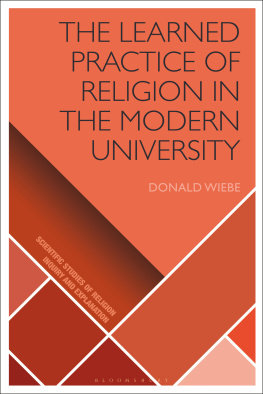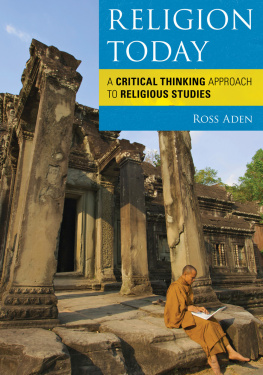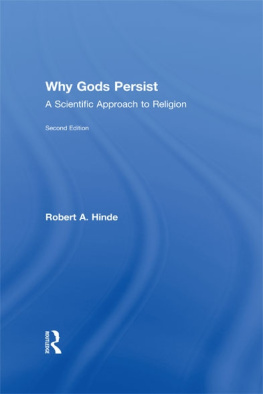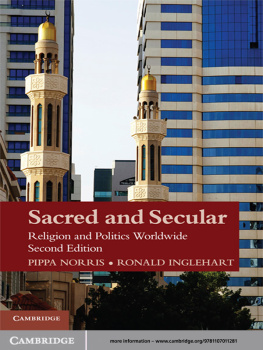First published 2011 by Ashgate Publishing
Published 2016 by Routledge
2 Park Square, Milton Park, Abingdon, Oxon OX14 4RN
711 Third Avenue, New York, NY 10017, USA
Routledge is an imprint of the Taylor & Francis Group, an informa business
Copyright 2011 Enzo Pace
Enzo Pace has asserted his right under the Copyright, Designs and Patents Act, 1988, to be identified as the author of this work.
All rights reserved. No part of this book may be reprinted or reproduced or utilised in any form or by any electronic, mechanical, or other means, now known or hereafter invented, including photocopying and recording, or in any information storage or retrieval system, without permission in writing from the publishers.
Notice:
Product or corporate names may be trademarks or registered trademarks, and are used only for identification and explanation without intent to infringe.
British Library Cataloguing in Publication Data
Pace, Enzo.
Religion as communication : Gods talk. 1. Religion and sociology.
I. Title
306.6dc22
Library of Congress Cataloging-in-Publication Data
Pace, Enzo.
Religion as communication : Gods talk / Enzo Pace.
p. cm.
Includes bibliographical references and index.
ISBN 978-1-4094-3523-5 (hardcover : alk. paper) 1. ReligionPhilosophy. 2. CommunicationReligious aspects. I. Title. II. Title: Gods talk.
BL51.P24 2011
306.6dc23
2011021375
ISBN 9781409435235 (hbk)
ISBN 9781315604886 (ebk)
Introduction
Secularization Theory and its Limits
The idea that religion would undergo an inexorable decline and that all things holy would progressively lose their plausibility was born of a blunder. The assumption was that the more we became modernized, the less we would need religion, in a linear process of eclipse of the sacred predicted by the generation of sociologists of religion coming soon after World War Two, between 1960 and 1970, and based on empirical data emerging from their preliminary investigations: there were fewer people going to church, fewer vocations for the priesthood, a tendency to use personal judgment (instead of consulting religious authorities) in decisions concerning moral issues, a declining sense of membership, and faith had become a private concern. The sociologists convictions were sometimes translated into ideological reasonings, particularly when religion was openly challenged as the enemy of modernity and of a secularism imposed by a political power.
For many years, secularization as an ideology (Acquaviva and Stella 1989; Martelli, 1990) clearly became the conceptual horizon of the first generation of sociologists of some of the East European countries dominated at the time by the Soviet Communist model. Now, several years on, when we reread the research conducted in Poland between 1960 and 1980, we see how strongly the sociological analysis of the phenomenon of religion was influenced by different ideological affiliations. On the one hand, there were those whobased on orthodox Marxist premisesbelieved that the processes of change then underway in Polish society showed all the symptoms of a decline in the force of religion; on the other, the sociologists and intellectuals of Catholic inspiration were demonstrating that the Polish peoples devotion, participation, and religious vitality were not only not declining, they were showing signs of a reawakening. Such a striking diversity of interpretation obviously had to do with the authors different political and ideological preferences. There was clearly a rift dividing those who were in favor of the political regime from those who were against it.
In the case of Poland, the Catholic Church was on the side of the opposition and, through the language of religion, it interpreted the needs and hopes of social and political freedom of millions of people, who were not necessarily all Catholics or practicing believers (Pace 1984; Michel 1989, 1994). When you visited Poland between 1979 and 1985, it was not unusual to meet what were then called devout Catholic atheists, people who were struggling against the Communist regime and saw the Catholic Church as the only moral entity capable of opposing the dominant power. In the initial throes of the Polish Revolution (between 1980 and 1988), religion enabled people to imagine another society, it became a way for people to speak about the chances of another social and economic model. More importantly, it invented a present that still does not exist even today. What was noticeable then, for instance, if you happened to be in Warsaw or Krakow, or Gdansk, on any Sunday in winter, was the silence that reigned over the roads towards evening, a silence that was suddenly interrupted by enormous crowds spilling out of the churches at the end of Mass. This was not just the spontaneous confusion typically seen when the doors of a church are opened, with people milling about and exchanging greetings, chatting in the churchyard with friends and acquaintances. What tended to happen was that the crowd would soon be transformed into a genuine organized protest march, complete with national flags and slogans against the regime in power. This happened increasingly often, as the Poles progressively became convinced that they could change the course of their history, and as the reaction of the political regime became increasingly repressive. The organization of the marches even contained a hint of mockery: as soon as the police showed up, this parade of churchgoers that had emerged from Mass and turned into a protest march rapidly dispersed and little groups silently formed around the bus and tram stops, pretending they were waiting for transportan ironic reaction in the face of which the police no longer knew what to do or who to hit. It is by no means easy to be ironic when faced with a policeman and, in the Polish case, this behavior can be explained in two ways: the power of the multitude and the power of faith. All these individuals felt that they were not alone, that they could count on an ample, widespread, and reassuring solidarity. Whether they were really believers or not, they were aware that they knew the right words in contrast with the regime. Along with many other people like themselves, they understood the power of religion in that particular historical situation. It was certainly not by chance that the collective movement that ultimately succeeded in pooling all the forces of opposition (secular and Catholic, post-Marxist and reformist left-wing, Jews and Orthodox Christians) was to go by the name of Solidarno (Bova 2003) and that the charismatic figure of a Polish Pope, in the person of John Paul II, was to carry a considerable weight.
The long movie being enacted during those years in the squares and stadiums of Poland, under the directorship of the Catholic Church, frequently showed footage involving two leading actors: on the one hand, there was a leader, with his people joined in prayer around him; on the other, there was a charismatic interaction, where what counted was not only the words that were spoken, but also the silences, and even more the pure image of a merging of hopes, the hopes of a Polish Pope convinced of the need to put an end to the Communist regime (and not only in Poland) and the hopes of the majority of the people who had had enough of mass poverty and ideological totalitarianism (Guizzardi 1983).







